What you will need
- Putty (synthetic) and putty knife
- Caulking compound (polyvinyl acetate type, in both rope and bulk form)
- Packaged ready-mixed mortar (if repairing masonry walls)
- Solvent, such as cleaning fluid
- Small pointing trowel
- Chisel (small, narrow blade, with a steel-capped handle)
- Masonry joint finishing tool (if repairing masonry walls and the existing masonry joints are "concave" joints)
Caulking cracks and holes (non-masonry)
- Check the following places for cracks and holes that need caulking
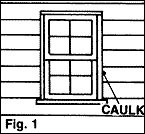 Between window and door frames and the main frame of the house.
Between window and door frames and the main frame of the house.
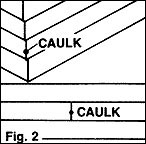 Gaps in sidings and at corners of house.
Gaps in sidings and at corners of house.
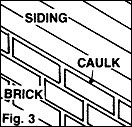 Joints formed by siding and masonry.
Joints formed by siding and masonry.
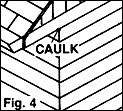 The underside of eaves where wall and eave meet and the surface of wood siding, trim and fascias.
The underside of eaves where wall and eave meet and the surface of wood siding, trim and fascias.
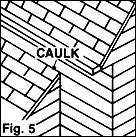 The joints where steps and porches meet the house.
The joints where steps and porches meet the house.
- Before applying new caulking (or putty), remove the old and wipe the area clean with a cloth soaked with a solvent similar to cleaning fluid.
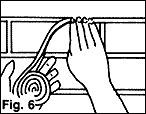 Most joints can be caulked with the "rope form" caulking. Unwind the caulk and force it into the cracks with your fingers (Figure 6).
Most joints can be caulked with the "rope form" caulking. Unwind the caulk and force it into the cracks with your fingers (Figure 6).
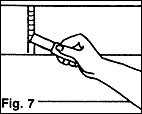 For large openings or cracks, such as gaps between lengths of siding, use "bulk" caulking and apply with a putty knife or small trowel as picutured in Figure 7. Clean away excess as you work.
For large openings or cracks, such as gaps between lengths of siding, use "bulk" caulking and apply with a putty knife or small trowel as picutured in Figure 7. Clean away excess as you work.
- To seal around glass in windows and doors, use putty and apply with a putty knife (Figure 8). Lay a small roll of putty, 1/8-inch to 1/4-inch thick, around the sash or frame so that it fills the groove in which the glass rests. Make sure that the putty is fully applied to both the glass and the sash or frame. Press the putty firmly with the knife to assure a good seal. Trim away excess as you work.
 For holes in wood surfaces, use putty and apply with a putty knife.
For holes in wood surfaces, use putty and apply with a putty knife.
Filling masonry cracks
- Use the chisel to chip out loose mortar from all joints to be filled.
- Mix a batch of mortar according to the package directions.
- Wet the masonry thoroughly before you begin and keep it wet as you work.
 Apply the mortar with a small pointing trowel, illustrated in Figure 9. Press the mortar firmly into the joint, making sure the joint is full.
Apply the mortar with a small pointing trowel, illustrated in Figure 9. Press the mortar firmly into the joint, making sure the joint is full.
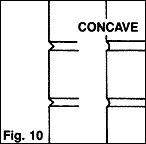 Take off the excess mortar with the edge of the trowel. Now finish the joint to match the existing joints (Figure 10).
Take off the excess mortar with the edge of the trowel. Now finish the joint to match the existing joints (Figure 10).
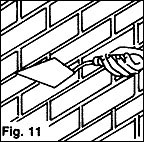 You can make the V-shape with the tip of the pointing trowel. Hold the trowel at a 45-degree angle to the joint, push the tip into the joint and then firmly move the trowel along the joint (Figure 11).
You can make the V-shape with the tip of the pointing trowel. Hold the trowel at a 45-degree angle to the joint, push the tip into the joint and then firmly move the trowel along the joint (Figure 11).

 You'll need a special masonry tool called a "jointer" to make a concave joint (Figure 12). Place the jointer over the mortar joint lengthwise and press the mortar firmly into the joint to form the concave shape (Figure 13).
You'll need a special masonry tool called a "jointer" to make a concave joint (Figure 12). Place the jointer over the mortar joint lengthwise and press the mortar firmly into the joint to form the concave shape (Figure 13).
- Fill and finish a joint (equal to 8 to 10 brick lengths) before you start another.
- Keep the newly filled joints damp for 2 or 3 days by frequently wetting with a fine spray from a water hose or by covering with wet burlap.









0 Comments